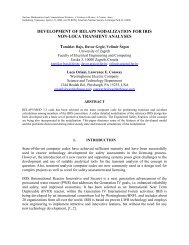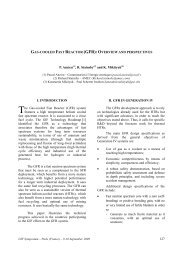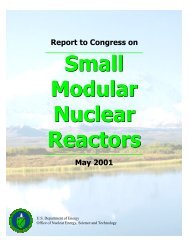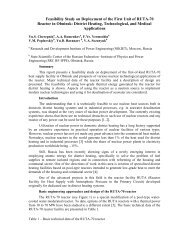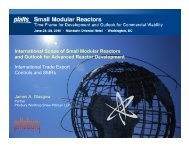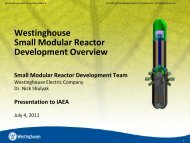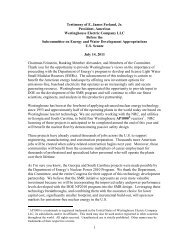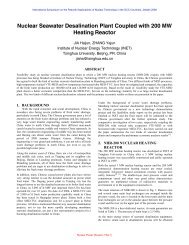Economic and Employment Impacts of Small Modular Reactors - SMR
Economic and Employment Impacts of Small Modular Reactors - SMR
Economic and Employment Impacts of Small Modular Reactors - SMR
- No tags were found...
Create successful ePaper yourself
Turn your PDF publications into a flip-book with our unique Google optimized e-Paper software.
The basis for estimating the magnitude <strong>of</strong> the economic impacts from the development <strong>of</strong> a domestic<br />
<strong>SMR</strong> industry is the marketing analysis described above. Each <strong>of</strong> the four scenarios used in estimating<br />
the dem<strong>and</strong> for <strong>SMR</strong>s provides the projected numbers <strong>of</strong> <strong>SMR</strong>s manufactured in the U.S., deployed in<br />
the U.S., <strong>and</strong> in operation in the U.S. on an annual basis through 2030. The economic impact analysis<br />
employed here is developed using these annual projections by using the previously-‐described 100 MW<br />
prototypical <strong>SMR</strong> as a basis for analysis.<br />
The impacts stemming from the domestic manufacturing <strong>and</strong> on-‐site construction <strong>of</strong> each 100 MW <strong>SMR</strong><br />
unit are first estimated <strong>and</strong> then aggregated across the number <strong>of</strong> units projected in each <strong>of</strong> the four<br />
marketing analysis scenarios. There are additional impacts stemming from the annual operation <strong>of</strong> each<br />
<strong>SMR</strong> deployed in the U.S. The economic impacts <strong>of</strong> operating each 100 MW <strong>SMR</strong> unit are estimated <strong>and</strong><br />
aggregated across the number <strong>of</strong> <strong>SMR</strong> units in operation in the U.S. for each <strong>of</strong> the four scenarios.<br />
Input-Output Analysis<br />
The economic impacts <strong>of</strong> manufacturing, construction, <strong>and</strong> operation <strong>of</strong> <strong>SMR</strong>s are calculated using<br />
st<strong>and</strong>ard estimation techniques collectively known as Input-‐Output (I-‐O) analysis. An underlying concept<br />
in I-‐O analysis is the notion that industries are closely linked <strong>and</strong> that economic activity in one industry<br />
ripples across other sectors <strong>of</strong> the economy, generating impacts both directly <strong>and</strong> indirectly. The direct<br />
effects <strong>of</strong> an industry stem from the employment <strong>and</strong> salaries in the industry itself. In addition, there<br />
are secondary, or indirect impacts when the activity in one industry affects related industries. Each<br />
industry purchases raw inputs from other industries that add value to their product or service. These<br />
other industries in turn purchase inputs from still more industries that add value to their product or<br />
service. These types <strong>of</strong> purchases from constitute the indirect effects <strong>of</strong><br />
the economic activity <strong>of</strong> the original industry. Finally, there are the induced economic impacts caused by<br />
the direct <strong>and</strong> indirect dollars being re-‐spent in the economy. The direct, indirect, <strong>and</strong> induced economic<br />
impacts are well known to economists <strong>and</strong> are calculated using I-‐O analysis.<br />
In terms <strong>of</strong> the economic impacts <strong>of</strong> the <strong>SMR</strong> industry, the direct effects stem from the actual change in<br />
final dem<strong>and</strong> for <strong>SMR</strong> units. An increase in <strong>SMR</strong> dem<strong>and</strong>, for example, will create additional<br />
employment <strong>and</strong> salaries within the <strong>SMR</strong> industry. The indirect effects stem from the purchases <strong>of</strong><br />
goods <strong>and</strong> services by the <strong>SMR</strong> industry from suppliers in other domestic industries. In effect, the <strong>SMR</strong><br />
industry, as its purchases from other firms, ripple through the economy in a chain-like<br />
manner. The induced effects stem from the increase in wage <strong>and</strong> salary earnings <strong>and</strong> other<br />
household income that ripples though the economy as direct <strong>and</strong> indirect dollars are spent <strong>and</strong> re-‐spent<br />
in the national economy. The biggest driver <strong>of</strong> these induced effects is employee spending from wage<br />
<strong>and</strong> salary payroll <strong>and</strong> earnings.<br />
The presence <strong>of</strong> indirect <strong>and</strong> induced economic effects means that an initial increase in dem<strong>and</strong> for a<br />
tiplier effects is <strong>of</strong> primary<br />
concern in I-‐O analysis <strong>and</strong> is an important component in determining the overall economic impacts <strong>of</strong><br />
industry changes. In essence, multipliers determine how the direct change in final dem<strong>and</strong> <strong>of</strong> a single<br />
26



